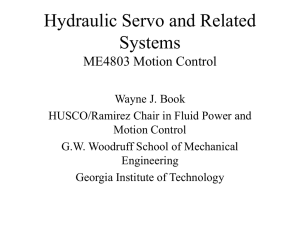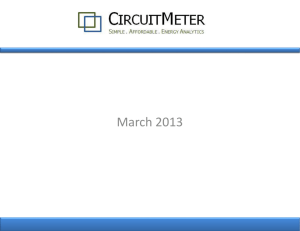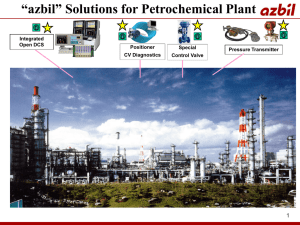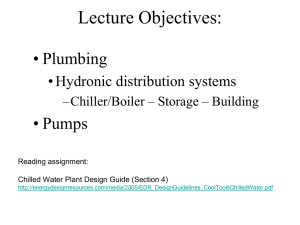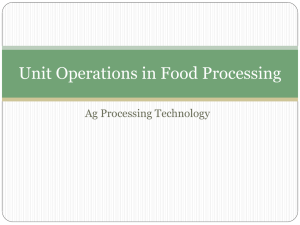Basic Operation of the Servo Valve (single stage)
advertisement
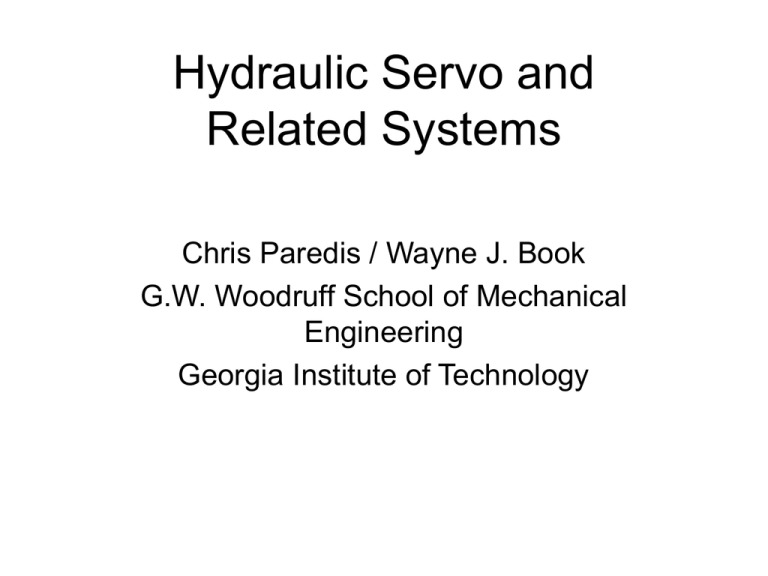
Hydraulic Servo and Related Systems Chris Paredis / Wayne J. Book G.W. Woodruff School of Mechanical Engineering Georgia Institute of Technology Lecture Overview • • • • • Why fluid power? Basic fluid-power circuits Simple dynamic model Efficiency considerations Advanced metering methods Hydraulics is Especially critical to the Mobile Equipment Industry The Strengths of Fluid Power (Hydraulic, to a lesser extent pneumatic) • High force at moderate speed • High power density at point of action – Fluid removes waste heat – Prime mover is removed from point of action – Conditioned power can be routed in flexible a fashion • Potentially “Stiff” position control • Controllable either electrically or manually – Resulting high bandwidth motion control at high forces • NO SUBSTITUTE FOR MANY HEAVY APPLICATIONS Difficulties with Fluid Power • Possible leakage • Noise generated by pumps and transmitted by lines • Energy loss due to fluid flows • Expensive in some applications • Susceptibility of working fluid to contamination • Lack of understanding of recently graduated practicing engineers – Multidisciplinary – Cost of laboratories – Displaced in curriculum by more recent technologies VoltageCurrent System Overview Electric RPM Trans- Flow Flow or IC mission Motor or Pump prime line & cylinder Press. mover Torque valve Press. RPM-Torque or VelocityForce Coupling mechanism • The system consists of a series of transformation of power variables • Power is either converted to another useful form or waste heat • Impedance is modified (unit force/unit flow) • Power is controlled • Function is achieved RPMTorque Load or VelocityForce Simple open-loop open-center circuit cylinder Actuating solenoid Pressure relief valve Spring return 4-way, 3 position valve filter Fluid tank or reservoir Fixed displacement pump Simple open-loop closed-center circuit Which is better in this case? Open- or closed center? Closed-loop (hydrostatic) system Motor Check valve Variable displacement reversible pump Drain or auxiliary line Axial Piston Pump Proportional Valve Basic Operation of the Servo Valve (single stage) Flow enters Torque motor moves spool left Flow exits Positive motor rotation Basic Operation of the Servo Valve (single stage) Flow enters Flow exits Torque motor moves spool right Negative motor rotation Orifice Model Q Cd Ao Q Cd Ao 2 p p Cd orificeflow discharge coef. Ao orificeflow area w x Cd orificeflow discharge coef. Ao orificeflow area w x 2 4 Way Proportional Spool Valve Model • Spool assumptions q1 q2 – No leakage, q1 C ps p1 x, C a const ant equal actuator areas q2 C p2 p0 x – Sharp edged, steady flow ps p1 p2 p0 p2 – Opening area proportional to x Load pressure: p p1 p2 – Symmetrical p p p p – Return pressure is zero so : p1 s ; p2 s 2 2 – Zero overlap ps p x ps p0 q1 C ps p1 x C • Fluid assumptions p0 2 – Incompressible x – Mass density p2, q2 p1, q1 Dynamic Equations (cont.) Expandin a T aylorseries to first order tolinearize q q1 q1 1 x q (p p ) (high order terms) ( x x ) 1 x x p x x p p p p T akingpartialderivatives : q1 x x x p p ps p C ; 2 q1 p x x p p C x 2 2 ps p p0 Chooseoperatingpoint,commonly ps p0 x 0; p 0, at whichq1 0 q1 x x x p p ps q1 C K1 ; 2 p x x p p x K2 0 p2, q2 p1, q1 Dynamic Equations: the Actuator q1 Change in volume Change in density y q1 K1 x K2 p K1 x Ay Net area Ap If truly incompressible: • Specification of flow without a response in pressure brings a causality problem • For example, if the piston has mass, and flow can change instantaneously, infinite force is required for infinite acceleration • Need to account for change of density and compliance of walls of cylinder and tubes Compressibility of Fluids and Elasticity of Walls p p N Bulk modulus: = 2 / m V / V 1 1 d 1 d ( M / V ) dp dp For the pure definition, the volume is fixed. q dt dM q dt; dp V More useful here is an effective bulk modulus that includes expansion of the walls and compression of entrained gasses 1 eff 1 d (M / V ) 1 1 M M V 2 dp V p V p Using this to solve for the change in pressure eff dp V dM k M dt k q dt Choices for modeling the hydraulic actuator With no compliance or compressibility we get actuator velocity v as q 1/A v With compliance and/or compressibility combined into a factor k And with moving mass m q k dt p dv/dt A /m Manufacturer’s Data: BD15 Servovalve on HAL Manufacturer’s Data: BD15 Servovalve on HAL Controls Issues: Summary • Nonlinearities • Good velocity control – Velocity approximately proportional to valve position – Bandwidth determined by compressibility and spool dynamics • How about position control? • How about force control? Lecture Overview • • • • • Why fluid power? Basic fluid-power circuits Simple dynamic model Efficiency considerations Advanced metering methods Open-loop open-center circuit – Revisited • Energy efficiency? p psource pload Qload Qsource Generated Power Useful Power Q Pressure-Compensated Load-Sensing Circuit p Energy Savings psource pload Qload Qsource Generated Power Useful Power Q Independent Metering: Introduction Independent Metering Configuration Pump F x Ksb Ksa B A Kbt Kat Tank Check Valve Advantages of Independent Metering: Metering Modes • Energy saving potential: Regenerative flow. Pump F x Ksb Ksa B A Kbt Kat Tank Check Valve Powered Extension Mode Advantages of Independent Metering: Metering Modes • Energy saving potential: Regenerative flow. Pump F x Ksb Ksa B A Kbt Kat Tank Check Valve High Side Regeneration Extension Advantages of Independent Metering: Metering Modes • Energy saving potential: Regenerative flow. Pump F x Ksb Ksa B A Kbt Kat Tank Check Valve Low Side Regeneration Extension Advantages of Independent Metering: Metering Modes • Energy saving potential: Regenerative flow. Pump F x Ksb Ksa B A Kbt Kat Tank Check Valve Powered Retraction Advantages of Independent Metering: Metering Modes • Energy saving potential: Regenerative flow. Pump F Ksb Ksa B A Kbt Kat Tank Check Valve Low Side Regeneration Retraction Advantages of Independent Metering: Metering Modes • Energy saving potential: Regenerative flow. Regeneration flow can be defined as pumping the fluid from one chamber to the other to achieve motion control of the load with using no or minimum flow from the pump. Summary • Main advantage of fluid power: – Very high forces/torques at moderate speed – Very high power density at point of action • Challenges: – Energy efficiency – hot research topic – Compactness (including prime mover) – User friendliness (leakage, noise, etc.) References 1. Norvelle, F.D. Fluid Power Control Systems, Prentice Hall, 2000. 2. Fitch, E.C. and Hong I.T. Hydraulic Component Design and Selection, BarDyne, Stillwater, OK, 2001. 3. Cundiff, J.S. Fluid Power Circuits and Controls, CRC Press, Boca Raton, FL, 2002. 4. Merritt, H.E. Hydraulic Control Systems, John Wiley and Sons, New York, 1967. 5. Fluid Power Design Engineers Handbook, Parker Hannifin Company (various editions).
